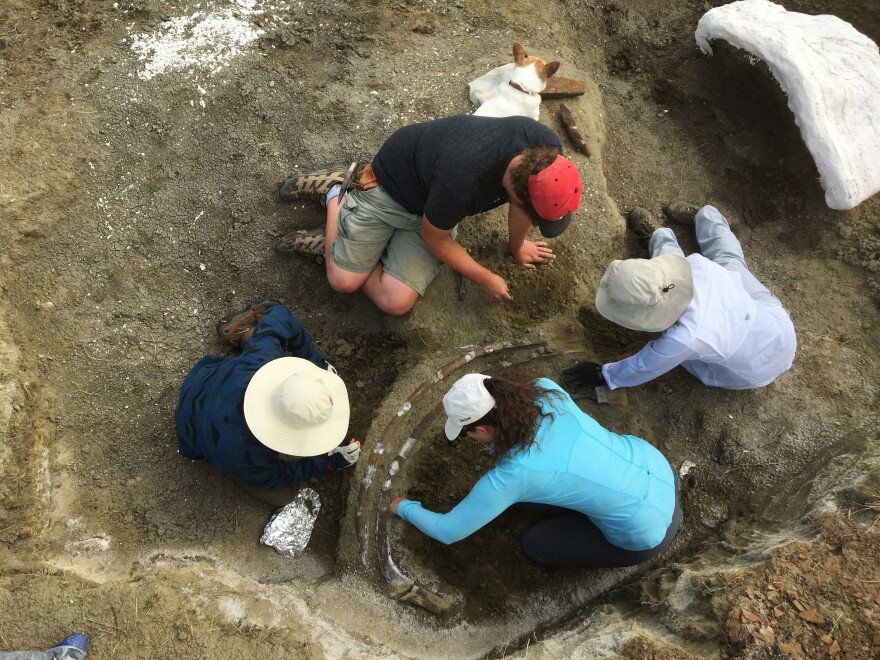For about 66 million years, a massive triceratops skull lay buried in the soft sandstone of the South Dakota Badlands — that is, until this summer, when Missouri paleontologist David Schmidt and his crew unearthed it.
At first, they weren’t sure what they had found.
“One of the very first bones that we saw in the rock was this long cylindrical bone,” said Schmidt, an associate professor of geology and environmental science at Westminster College near Jefferson City. “The first thing that came out of our mouths was, ‘That kind of looks like the horn of a triceratops.’”
Thought to be the skull of Triceratops prorsus, the fossil measures about seven feet long and weighs more than 3,000 pounds. The team spent about two months carefully excavating the rare specimen, which may eventually shed more light on the lives of these prehistoric creatures.
The triceratops skull would have remained hidden in a lonesome patch of prairie, had it not caught the attention of a local rancher in March 2019.

The rancher was repairing a fence along the boundary of the Grand River National Grassland when he noticed a weathered piece of bone sticking out of the ground. Federal law prohibits the collection of paleontological or cultural artifacts on public lands — so he reported it to the local authorities.
In an extraordinary case of being in the right place at the right time, Schmidt and a crew of Westminster College students had just arrived in the area for their annual collecting trip.
“The park rangers asked us if we would go out and do just a very preliminary surface survey,” Schmidt remembers. “We had to be really careful. We couldn't disturb anything at all, because at that point, it was under law enforcement investigation. They were telling us, ‘Don't even make footprints,’ and I was thinking, ‘How are we supposed to do that?’”
Eventually, the authorities concluded the fossil was within the boundaries of the park and gave Schmidt the green light to begin digging.
In June, more than a year after the fossil was first discovered, his small team of current and recent undergraduates began the painstaking process of excavating it.

They dug down about seven feet in some places, using pickaxes and shovels to remove the crumbling sandstone.
“As we continued to uncover more parts of the skull, I was in denial,” Schmidt said. “I was thinking, ‘This can't be a skull. How lucky would I be? That probably only happens to a very tiny fraction of people on this planet. Like, I can't be one of those.’”
A rare find
Finding the skeleton of this particular triceratops species is “exceedingly rare,” said paleontologist Peter Larson, who wasn’t involved in the project. Larson led the team that unearthed Sue, the largest and most complete Tyrannosaurus rex skeleton ever found, about 40 miles from Schmidt’s site.
“Apparently, this triceratops species was very, very tasty,” Larson said. “They were one of T. rex's favorite foods. When they would feed on a triceratops carcass, they’d not just eat the flesh, they’d also eat a whole lot of the bones, too.”
As a result, many triceratops bones were crushed and scattered across the landscape.
Perhaps even more important, Larson said, this particular triceratops fossil was found near the Cretaceous-Paleogene, or K-Pg, boundary, a thin black band of sediment created when a massive asteroid crashed into modern-day Mexico — and eventually led to the extinction of 75% of all species on Earth.
“If this one is more or less a whole skeleton, it's going to be very important to our understanding of those last few remaining millennia that dinosaurs were on this planet,” Larson said.

It’s still unclear how much of the triceratops skeleton Schmidt and his crew were able to collect.
“We were uncovering more and more bones, but we got to a point where we couldn't collect any more,” Schmidt said, who plans to return to the site next summer. “We feel like, based on what we've seen so far, we may have quite a bit of the skeleton there, which is very, very exciting.”
Last month, the team carefully encased the skull in a protective layer of plaster, lashed it to a backhoe and loaded it on a flatbed trailer to transport it more than 800 miles to Westminster College.
Schmidt and his students will soon begin the slow process of removing the plaster and sediment from the skull and piecing together the many bones found with it.
In the end, he said, they were extremely lucky.
“You dream about these kinds of moments when you're a kid,” he said. “You don't ever think that these things will ever happen.”
Follow Shahla on Twitter: @shahlafarzan


